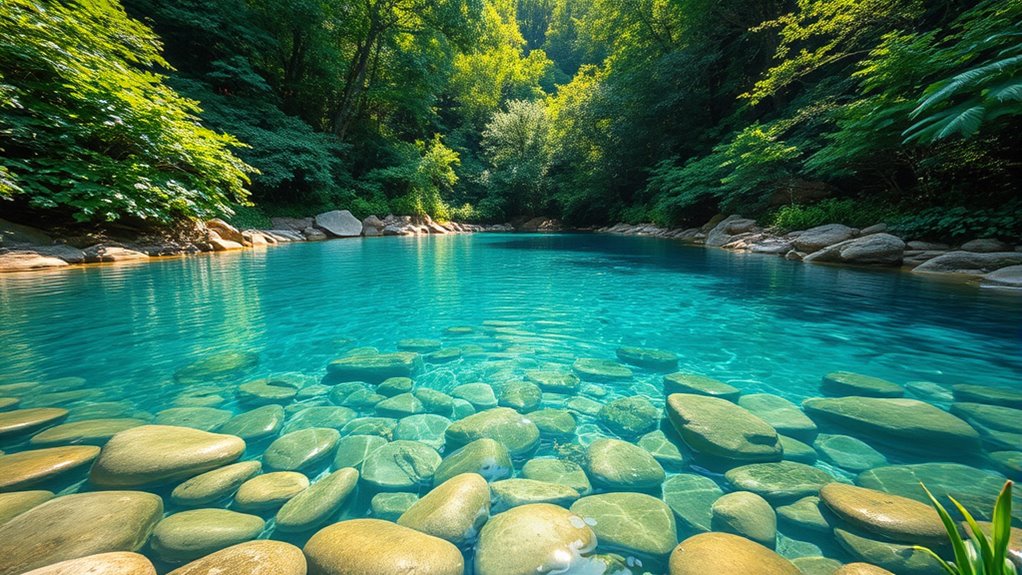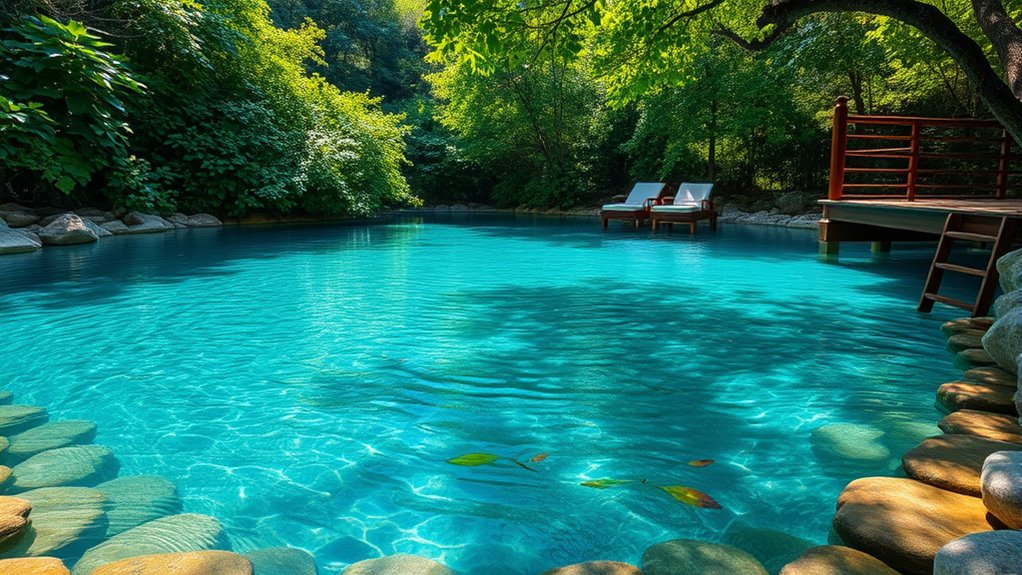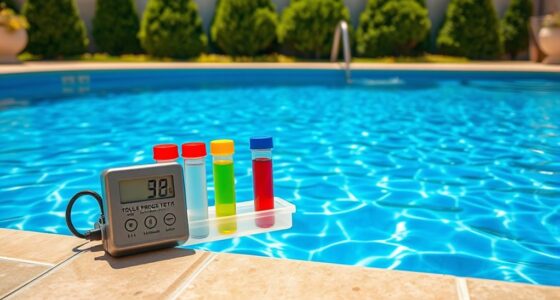A beginner’s guide to natural swimming pools shows that these eco-friendly pools use plants and biological filters instead of chemicals to keep the water clean. You’ll want to focus on designing different zones, like a regeneration area with aquatic plants that absorb nutrients and filter the water naturally. Proper water flow and strategic plant placement are key to maintaining clarity and balance. If you keep exploring, you’ll gain the knowledge needed to create a beautiful, sustainable natural pool.
Key Takeaways
- Natural pools use biological filters and plants instead of chemicals to maintain clean, clear water.
- Proper water flow through regeneration zones is essential for organic matter breakdown and ecosystem health.
- Select and place aquatic plants like reeds and water lilies strategically to optimize nutrient absorption and filtration.
- Regular maintenance, including trimming plants and removing debris, keeps the ecosystem balanced and water quality high.
- Designing a natural pool involves mimicking ecosystems, ensuring water circulation, and choosing suitable plant species for local climate.

Natural swimming pools offer an eco-friendly alternative to traditional chlorinated pools by using biological filters and plants to keep the water clean. Unlike conventional pools that rely on chemicals, natural pools mimic ecosystems, combining water filtration methods with strategic plant selection to maintain clarity and hygiene. This approach requires understanding how water flows through the system and how plants contribute to filtration. Proper water circulation ensures that the biological processes are effective and sustainable. Your first step is focusing on water filtration. In natural pools, water moves through a series of zones, including a regeneration area where biological processes occur. This zone is essential for breaking down organic matter and removing impurities. You’ll want to design a system that encourages water circulation, ensuring that contaminated water continually passes through the biological filters. Mechanical filters may be used initially, but the heart of the system is the biological component, which relies on specific plants and bacteria to keep the water clean. Proper water filtration prevents algae buildup and keeps the pool inviting without chemicals.
Natural pools use biological filters and plants to maintain clean, chemical-free water.
Plant selection is equally crucial. You need to choose plants that are well-suited for water filtration and thrive in your local climate. Aquatic plants like water lilies, reeds, and sedges are common choices because they absorb nutrients from the water, reducing algae growth. Vegetation around the edges, such as marsh grasses, can also help stabilize the ecosystem and prevent soil erosion. When selecting plants, consider their root systems, growth rate, and ability to survive submerged or semi-submerged conditions. Healthy, diverse plant life creates a natural balance, ensuring the biological filters work efficiently. Additionally, understanding color accuracy and how it influences visual appeal can help you select plants that complement your pool’s aesthetic.
Placement matters, too. Position water-loving plants in the regeneration zone where they can access nutrients directly from the water. For ideal water filtration, arrange your plants in zones that facilitate water flow from the swimming area to the filtration beds. Regular maintenance of plants is essential—trim back overgrowth and remove any decaying plant material to prevent water quality issues.
Frequently Asked Questions
How Much Does Installing a Natural Swimming Pool Typically Cost?
You can expect the cost estimate for installing a natural swimming pool to range from $20,000 to $50,000, depending on size and features. You might want to explore financing options to make it more affordable. Keep in mind, choosing eco-friendly materials and custom designs can influence the price. Planning ahead and comparing quotes will help you find the best deal and guarantee your investment fits your budget.
Are Natural Swimming Pools Suitable for All Climates?
Natural swimming pools can be suitable for many climates, but their climate adaptability hinges on your region’s temperature and weather patterns. If you live in a warmer climate, you’ll likely find it easier to maintain water quality year-round. In cooler regions, you might need additional heating or cover systems to ensure regional suitability. Assess your local climate conditions and consult with experts to determine if a natural pool fits your specific environment.
What Maintenance Is Required for Natural Pools?
You’ll need to regularly check and clean your natural pool’s filter to guarantee it functions properly, which helps maintain water clarity. Algae control is essential, so you should monitor and manage algae growth by balancing nutrients and using natural methods like aquatic plants. Routine maintenance also includes removing debris, inspecting the biological filter, and ensuring circulation stays consistent. Staying on top of these tasks keeps your pool healthy and inviting.
How Long Does It Take to Build a Natural Swimming Pool?
Building a natural swimming pool typically takes 3 to 6 months, depending on your construction timeline and design considerations. You’ll need to plan carefully, considering factors like size, shape, and location, which influence how long the project lasts. Coordinating with professionals and obtaining permits can also impact your schedule. With proper planning, you’ll soon enjoy a beautiful, eco-friendly pool that blends seamlessly into your landscape.
Can I Swim in a Natural Pool Year-Round?
You can swim in a natural pool year-round if you maintain proper pool temperature and provide seasonal heating options. In colder months, using solar covers or heaters helps keep the water warm enough for comfortable swimming. Keep in mind, seasonal swimming depends on your climate and personal comfort. With the right insulation and temperature management, you can enjoy your natural pool throughout the year without interruption.
Conclusion
Creating a natural swimming pool is like planting a garden—you nurture it with care, and it flourishes beautifully. I once met a homeowner who transformed their backyard into a lush oasis, and now, their kids spend hours swimming in crystal-clear, chemical-free water. Just as a garden needs patience and attention, your pool will reward you with serenity and sustainability. Embrace the journey, and you’ll enjoy a revitalizing, eco-friendly retreat right at home.









